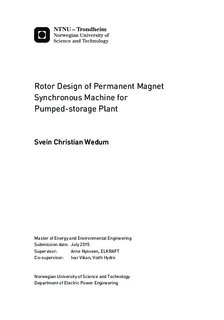Rotor Design of Permanent Magnet Synchronous Machine for Pumped-storage Plant
Master thesis
Permanent lenke
http://hdl.handle.net/11250/2368253Utgivelsesdato
2015Metadata
Vis full innførselSamlinger
- Institutt for elkraftteknikk [2465]
Sammendrag
This master thesis is partly a deeper study of which was presented in the specialization project, fall of 2014. The main objective have been to develop and design a permanent magnet synchronous machine for hydro power plant application. In this study, an analytical design tool for this purpose was developed through a Matlab script. The analytical calculations have been veried by use of nite element method analysis in machine no-load operation, and the design tool is found suciently accurate for this study.As background, a literature survey was performed, which resulted in the base for developing the analytical design tool. The relevant equations are presented in the theoretical part of this thesis.A synchronous machine at 18 MVA with eld windings have been redesigned by use of permanent magnet magnetization. The stator bore diameter was kept constant at 3.51 m in all machines simulated. At a decreased air gap of 11.0 mm, the synchronous reactance of the permanent magnet synchronous machine was computed to be 0.6 pu, and the usage of permanent magnet material to 1247 kg at minimum, in case of the desired input parameters. In this machine, the height of the surface mounted magnets were 35.3 mm, distributed in 12 poles.It has been observed possibilities for reduction in both mass and size by redesign to a permanent magnet synchronous machine, the former in greatest extent. The machine eciency was also raised in case of the permanent magnet synchronous machine, from 97.6 to 98.0 %.
